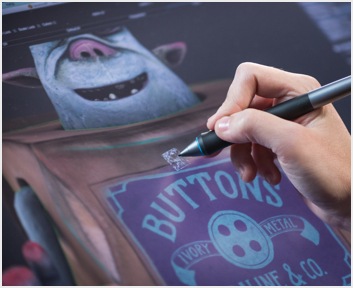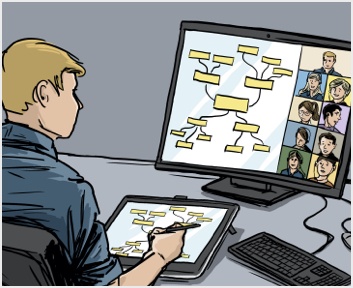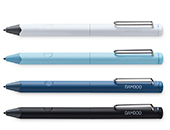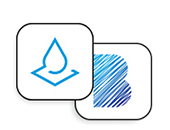
Pride of Wacom - 得意之作
無論何時何地,都能保持「高度專注力的創作」
:
去除非必要元素,專注於關鍵部分
A bold new look for the Wacom Intuos Pro
The Wacom Intuos Pro has long been the signature pen tablet in Wacom’s product lineup. Now, for the first time in eight years since its 2017 release, this flagship model has undergone a bold transformation. While preserving the exceptional expressiveness and intuitive control that creators expect, everything from its external design to its internal engineering has been refined.
Embracing the trend of pen tablets evolving toward thinner and lighter designs, the new Wacom Intuos Pro has been meticulously designed to meet the usability needs of creative professionals while offering a refined, premium aesthetic.
The redesigned Wacom Intuos Pro features a newly developed IC that was five years in the making, delivering a remarkable leap in performance. To fully harness its capabilities and support creators in their work, the placement and design of buttons and switches — the hardware interface — were completely reimagined from the ground up.
How was the previous Wacom Intuos Pro used in creative environments? What kind of product would creators feel comfortable adopting without distraction? And what new possibilities could the redesigned Wacom Intuos Pro offer?
Through an in-depth study of creators’ needs and working styles, countless refinements were made in pursuit of the ideal design — a process that unfolded day by day until, at last, this new model took shape.

A Deep Dive into the Creative Workflow
Around three years ago, Wacom launched the ETC* task force to pursue the development of a new flagship pen tablet in response to creator feedback. This marked the beginning of the journey toward the next-generation Wacom Intuos Pro. Leading the design efforts was Naoya Nishizawa, Director of Design for Technology & Experience. With a clear vision for what the new Wacom Intuos Pro should be, he set out to carefully reimagine the product from the ground up, focusing on one key concept: a product that blends seamlessly into creators’ workflows.
“The previous generation of Wacom Intuos Pro was originally developed with the concept of being a ‘one-device solution for all creative workflows.’ Whether for drawing or video editing, it was designed with the assumption that creators could complete their entire process using just this pen tablet. And indeed, many professionals have adopted it in exactly that way.
However, when we spoke with users of Wacom Intuos Pro, we discovered that a significant number of them incorporate a keyboard into their workflow as well. With this redesign, we returned to the core principle of ‘supporting the creator’s workflow.’ Rather than dictating what we believe to be the ideal way of working, we focused on creating a product that blends seamlessly into creators’ workflows,” explains Nishizawa.
A product designed first and foremost for creators — this philosophy became the foundation for the next-generation Wacom Intuos Pro.
*1 ETC: A cross-functional task force composed of dedicated members from different departments. This temporary team brings together specialized knowledge and expertise gained through daily work to solve specific challenges.

“One of the key design themes for the new Wacom Intuos Pro was to minimize the feeling of thickness as much as possible. When working at a desk, a thicker device can create an unwanted step at the edge, making the user feel as if their hand is “falling off.”
For creators, this sensation can break the creative flow. To eliminate this, the team pursued an ultra-slim form factor that minimizes thickness. A thinner design also means a lighter device, which is a significant advantage for the growing number of creators who work on the go.
“During development, we often discussed the idea of making it as thin as a single notebook—or ultimately, as thin as a sheet of paper. Of course, we’re still refining the technology, but with this new Wacom Intuos Pro, we’ve made a dramatic step forward in reducing thickness. Today’s creators prioritize mobility, so from the very beginning, our focus was on making the device thinner and lighter.
The previous generation of Wacom Intuos Pro was designed to be reversible, allowing users to flip it depending on their dominant hand, which required the overall thickness to be uniform. With this redesign, we reevaluated the placement and number of buttons, creating a more streamlined, intuitive design that feels natural for all users,” explains Nishizawa.”

One major change in the hardware user interface is the repositioning of the ExpressKeys, which allow users to assign custom shortcuts. In the previous model, some creators found that their hands would occasionally brush against the keys while using a keyboard, triggering unintended actions. To better fit seamlessly into professional workflows, the team carefully reconsidered the optimal placement of these buttons.
Nishizawa recalls that extensive discussions took place, not just about functionality, but also about what a high-end model should look and feel like.
“We tested numerous prototypes to determine the ideal design for Wacom’s flagship pen tablet. ExpressKeys are primarily used without looking, so we rigorously examined their usability from that perspective.
At the same time, I had a personal commitment to ensuring the device had a premium look and feel. Many of today’s creators use high-end products like DSLR cameras and drones, and I wanted the new Intuos Pro to sit naturally alongside such professional tools.
By keeping a clear image of our target users in mind, we were able to refine details such as the textured coating and stainless steel accents—features that make this a product creators will want to have close at hand,” says Nishizawa.
Nishizawa’s words reflect a deep confidence—not just in the functionality of the device, but in its ability to be a high-quality, beautifully crafted tool that creators will want to have with them at all times.
An Engineer’s Pride: Rising to Every Challenge
To bring the design envisioned by Nishizawa and his team to life, Masayuki Maeda, an EMR module mechanical engineer, played a crucial role from a structural engineering perspective. The process of turning design requests into a fully functional product presented numerous challenges.
“When pursuing a thinner and lighter device, the biggest challenges are strength and durability. For this model, we used a magnesium alloy body and refined the internal structure to maintain the same level of robustness as previous models. Additionally, we designed the profile with a subtle incline—thinner at the front where creators rest their hands and thicker at the back to house internal components. This concept is the same one we introduced with the Wacom Movink 13, released in 2024.
Since Wacom Intuos Pro is a pen tablet that requires a built-in battery, circuit design was also particularly complex due to its impact on thickness. However, in the end, we managed to reduce both thickness and weight to nearly half of the previous Wacom Intuos Pro,” explains Maeda.

There were also significant challenges in structural engineering. From a user interface perspective, this new Wacom Intuos Pro is the first Wacom product to feature five key tops within a single area. The team had to find a way to fit multiple buttons into a compact space while ensuring they worked in harmony with the newly introduced dial keys—an incredibly difficult task.
Adding this many buttons meant major adjustments in both circuit design and mechanical engineering. Fitting them seamlessly into the chassis while maintaining an aesthetically refined appearance was far more challenging than we had initially expected. The dial keys are positioned on both the left and right sides, and at one point, I even challenged the ETC team in charge of planning and the design team, asking, ‘Do we really need these?’
But after numerous discussions, I came to fully understand how much creators valued them, which motivated me to find the best technical solution. We also put great effort into fine-tuning the tactile feel and sound of pressing the buttons and turning the dials, ensuring they wouldn’t disrupt a creator’s workflow,”” says Maeda.
For this redesign, the team also doubled the number of Bluetooth connections. Some creators use the same pen tablet across two workstations, switching between them as they work.
While previous models allowed users to change the connection via software, the new Wacom Intuos Pro features a dedicated hardware switch, enabling faster and more intuitive switching. This improvement was made possible by closely observing real-world creative workflows.
Sustainability was another key focus. The Wacom Intuos Pro lineup includes three sizes, and the team made a concerted effort to standardize as many components as possible. If each size required entirely different parts, it would increase environmental impact through manufacturing and transportation.
Sustainability was another key focus. The Wacom Intuos Pro lineup includes three sizes, and the team made a concerted effort to standardize as many components as possible. If each size required entirely different parts, it would increase environmental impact through manufacturing and transportation.
"Standardizing parts can create design constraints, but rather than prioritizing development convenience, we remained committed to reducing environmental impact. It was a decision we engineers stood by because we knew it was the right thing to do,” recalls Maeda.
The challenges seemed almost impossible to overcome—finding a balance between all these factors at once. And yet, Maeda and his team faced each one with determination and even joy. For them, it’s the unknown challenges that bring the greatest sense of accomplishment.
Elevating the Performance of Our Premium Pen
Bundled with the Wacom Intuos Pro, the Wacom Pro Pen 3 is Wacom’s premier digital pen, offering exceptional quality in every aspect. It features high-precision pressure sensitivity and tilt detection, allowing creators to effortlessly switch between bold brush strokes and fine lines. Its customizability is another key strength—users can adjust the grip thickness, the number of side switches, and even the pen’s center of gravity to match their personal preferences.
With the new Wacom Intuos Pro, Wacom has introduced an additional rubber-like nib alongside the existing standard and felt nibs. Maeda explains the reasoning behind this addition:
"Some creators using the previous Wacom Intuos Pro mentioned that their nibs wore out quickly. To address this issue, we began by changing the material of the overlay sheet applied to the tablet’s surface. This improved the writing feel while also extending the lifespan of the nibs, reducing the frequency of replacements.

Additionally, with this new Wacom Intuos Pro, we are introducing a rubber-like nib. This nib provides a slightly softer writing feel while also being more durable. After testing countless samples, we found a material that delivers the new and refined drawing feel Wacom was seeking.
Now, creators can experience this new feel without needing to replace their overlay sheet. I hope users take full advantage of the unique experience that Wacom Pro Pen 3 offers.”
At the same time, Wacom has also redesigned the pen stand. Taking feedback from creators into account, the new design retains the best aspects of past stands while making the nib storage area more visually recognizable for improved usability.
“Initially, we considered a pen stand that could store all the interchangeable parts of the Wacom Pro Pen 3, as we wanted users to enjoy its customizability. However, after speaking with creators, we realized that portability wasn’t as important to them as we had assumed. Instead, they preferred a simpler, more streamlined design. This is another example of what we learned by listening to creators,” says Nishizawa.
Creating a New Pen Experience Through Design and Engineering
As a professional product designer, Nishizawa spoke about a personal lesson he always keeps in mind:
“At Wacom, one thing we always remind ourselves of is that we must never assume we fully understand a creator’s workflow. This is something I always discuss with my team. If we believe we understand it and dictate how our products should be used, that would be nothing more than arrogance.
Instead, we aim to provide a broad range of options so that creators can work in the way that suits them best.
If they find our suggestions helpful, that’s great. But even if they don’t, our design should never get in the way. That’s the ideal. Even if only two out of ten people need a certain feature, if it’s essential for them, we must deliver it. This mindset is deeply embedded in the design of the new Wacom Intuos Pro,” Nishizawa explains.
Holding the newly redesigned Wacom Intuos Pro in his hands, Maeda can hardly contain his excitement at the thought of creators experiencing its new features.
“Thinner and lighter—this concept is reflected throughout the product, and I take great pride in that. I hope creators take it with them wherever they go and truly enjoy using it.
The new nibs for the Wacom Pro Pen 3 also offer a distinct feel, and I believe creators will immediately notice the difference when they try them.
We paid meticulous attention to the tactile experience of the switches and dial keys, ensuring they are satisfying to the touch. If creators find themselves reaching for the tablet even outside of their creative work, just to feel its design, that would be the highest compliment an engineer could receive,” says Maeda.
With Nishizawa, Maeda, and a team of dedicated designers and engineers who brought their vision to life, Wacom Intuos Pro continues to set the standard for professional pen tablets. Designed to inspire and grow with creators, it’s exciting to imagine what new possibilities their next innovation will unlock.

釋放專業創作者的創意潛能
Wacom 得意之作 —— Wacom Pro Pen 3
閱讀文章致力於實現全方位最佳表現
為追求「完美平衡」不輕言放棄
閱讀文章把握每個「靈感乍現」的瞬間
Wacom 首款可攜帶繪圖螢幕成功問世
閱讀文章無論何時何地,都能保持「高度專注力的創作」
去除非必要元素,專注於關鍵部分
閱讀文章After 5 Years:
The New IC Enables The Best Pen Experience
Learn moreDesigned to Blend Seamlessly into Creative Workflows:
The Redesigned High-End Pen Tablet
Learn more

































